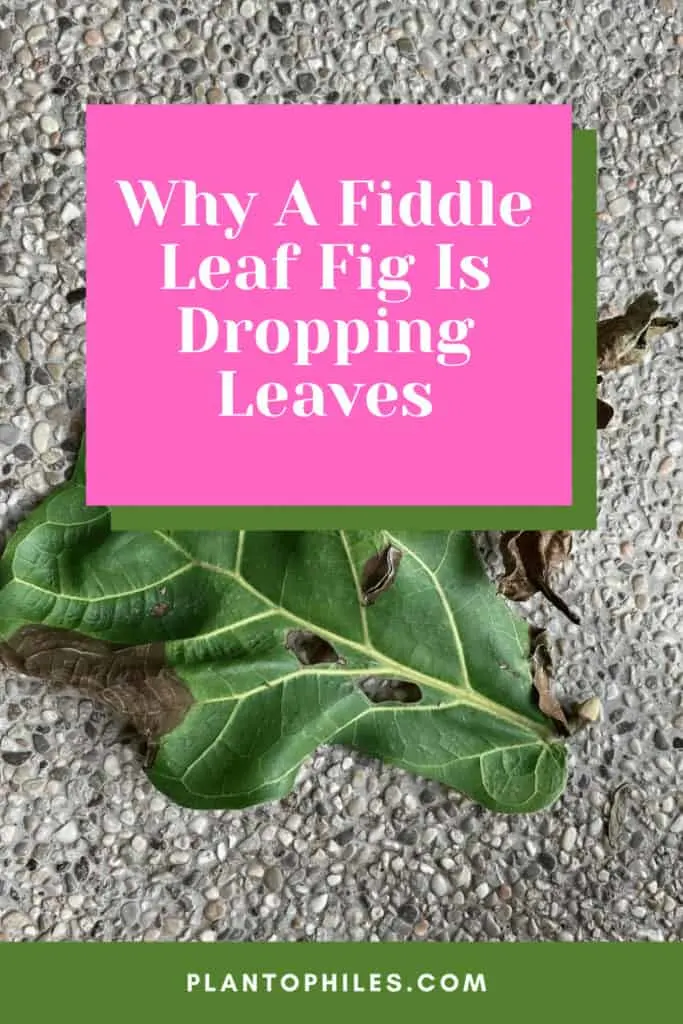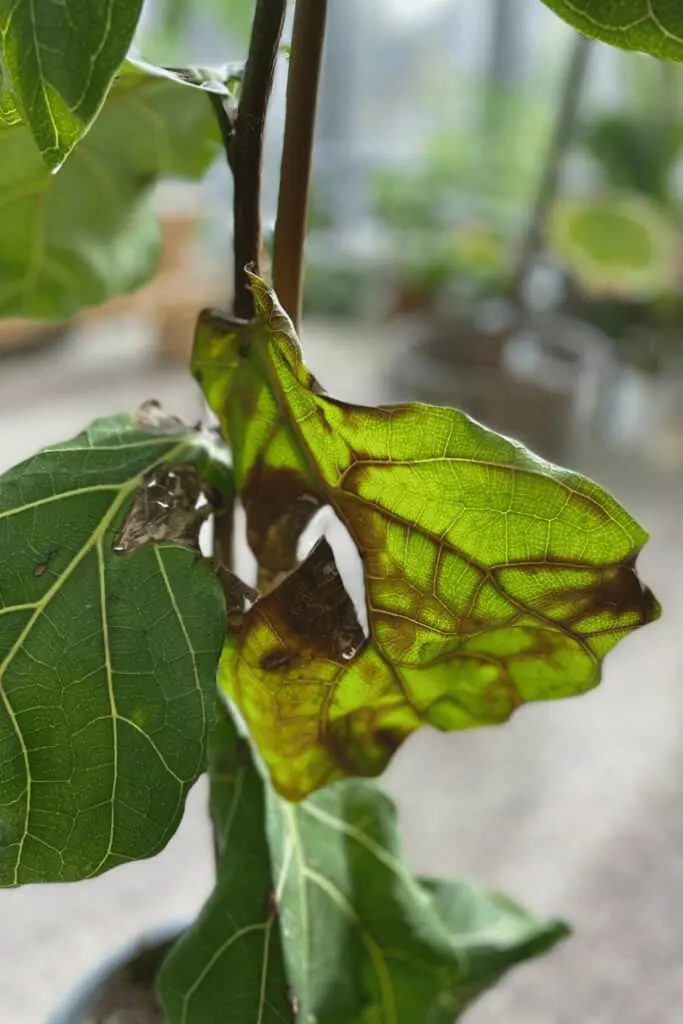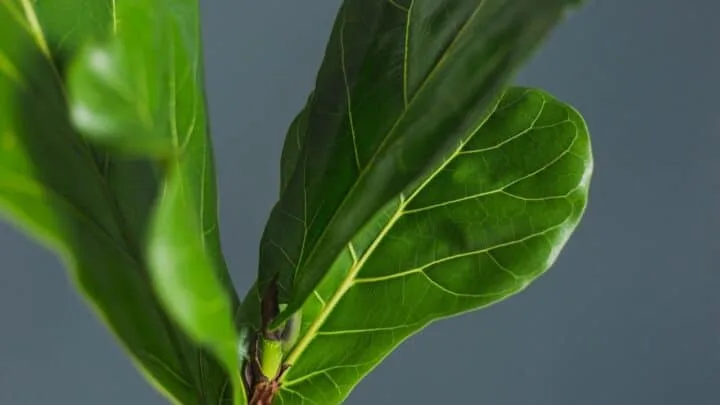Fiddle-leaf figs are some of the most beautiful indoor plants I have ever grown, and I am very proud of them.
So imagine my concern when I noticed my prized Ficus Lyrata or fiddle leaf fig was dropping leaves.
Was my plant dying? What should I do? Here’s what I discovered.
Table of Contents
Fiddle Leaf Fig Dropping Leaves
A Fiddle Leaf Fig dropping leaves is usually due to one of the following reasons: too much water, too little water, extreme cold or heat, sudden changes in light, bacterial infection, overfertilizing, or environmental stress.

8 Reasons Why Fiddle Leaf Figs Drop Leaves
1. Too Much Water
When you overwater your Ficus or Fiddle Leaf Fig, you not only cause the plant to experience a change in pH, but you also smother the roots, causing the Ficus to be unable to absorb nutrients and water in the correct proportions.
This was news for me—I had been overwatering my Ficus!
When the roots and potting soil are entirely saturated, it causes root rot occurs. My Ficus was dying because the seeds were no longer healthy.
2. Too Little Water
I discovered there’s a delicate balance between too little and too much water.
When a Ficus plant does not receive enough water, it will immediately affect the leaves, shrivel up and fall off.
Sometimes, the roots are so densely overgrown in the pot that water only reaches the outside roots, but the inside roots remain dry. This can also cause leaf fall.
Water your Fiddle Leaf Ficus with no more than 34 ounces of water per week for a large Ficus. The soil shouldn’t be soggy; at most, only damp.
3. Extreme Cold
In my home, I keep my Fiddle Leaf Ficus near the window in summer as the sunlight and heat benefit the plant.
So when I noticed a sudden leaf fall, I thought about what part I was doing wrong.
My neighbor had built an addition to his home, cutting off the sunlight and reducing the ambient temperature at my window by about four degrees Fahrenheit.
According to Today.com, Ficus prefers temperatures between 60 – 75 Fahrenheit all year round. Once I moved my Ficus to a warmer room, it began to recover.
I use my HVAC system in winter to increase the ambient temperature and ensure my Ficus is nice and toasty.

4. Extreme Heat
I gave my aunt a Ficus as a gift, and living in a warmer climate, she placed hers on the front porch, only to have the leaves fall off within a week.
I took a temperature reading, and her front porch is hellishly hot.
The temperatures well exceeded 75 Fahrenheit, which means the Ficus had begun to dehydrate and lose water through the leaves, which weakened the leaf structure, causing the leaf fall.
Moving her Ficus into a room with a lower ambient temperature solved the problem.
When her Ficus is experiencing too much heat, she knows to lower the temperature and increase the watering ratio slightly per week.
5. Consider Lighting Too
The Fiddle Leaf Ficus is sensitive to changes in light. Moving it from one room to the other is not a good idea.
My family knows that when I place my Ficus in a spot, it must remain there since it receives the best light.
I place my Ficus near windows facing South or West, and I always keep an eye on the leaf quality as this indicates whether the Ficus is happy.
Placing your Ficus in a windowless bathroom will result in leaf fall and death, so keep your Ficus happy.
6. Don’t Overfeed Your Fiddle Leaf Ficus
While you may think fertilizing the soil of your Ficus monthly is a good idea, I discovered it isn’t.
Initially, it may look like my Ficus is thriving, but within a few weeks, I noticed limp leaves, and soon leaf fall followed.
The roots had absorbed a lot of fertilizer, causing them to grow too fast, blocking out water absorption. This meant the water I was giving wasn’t reaching the plant.
7. Bacterial Infection
If you notice spotty leaves, you should remove them immediately to prevent further contamination.
However, if your Ficus is already in distress, you may have to remove all the leaves, repot it with new sterile potting soil, limit watering, and give it good light and time.

8. Stress
The Fiddle Leaf Ficus is a temperamental plant, and I find that if I move it or bring a new plant home, it will go through a period of stress.
Therefore, I always place it in a quiet room with minimal movement and good lighting to settle.
More vigorous plants adapt better to a new placement, but new plants can quickly shed leaves and die.
Why are the leaves of my Fiddle Leaf Fig falling off?
The most common reasons I have found why the leaves of my Fiddle Leaf Fig are falling off are:
- Overwatering
- Cold temperatures in winter
- Hot temperatures in summer
FLF is a finicky plant that looks great but demands the right care, or it will deteriorate quickly. The first thing that goes is usually the leaves.
Related: Fiddle Leaf Fig Care Guide
Frequently Asked Questions About Why A Fiddle Leaf Fig Is Dropping Leaves
Is it normal for Fiddle Leaf Fig to drop leaves?
A Ficus is an evergreen that usually drops leaves when it is distressed, sick, or dying. So, it isn’t normal for the fiddle leaf fig leaves to drop.
Why are my indoor fig tree’s leaves dropping?
When your Ficus is dropping leaves, you can consider the following reasons: Too much water, too little water, not enough light and too little heat, too much light and excessive heat, and environmental stress. Airflow from fans and AC units can also strip the Ficus of moisture and heat.
Will leaves grow back on fiddle leaf fig?
Once your Ficus has shed a leaf, that node will die. The plant will not regrow the same leaf, so ensuring the leaves remain healthy is important to ensure the Fiddle Leaf Ficus survives.
Will leaves grow back on fiddle leaf fig?
Once your Ficus has shed a leaf, that node will die. The plant will not regrow the same leaf, so ensuring the leaves remain healthy is important to ensure the Fiddle Leaf Ficus survives.
Turning A New Leaf
Finally, your Fiddle Leaf Ficus will eventually recover enough to grow new leaf nodes and produce new leaves, but given the size of each leaf, this will take some time.
When in distress, such as losing leaves, the Fiddle Leaf Ficus will need careful minding to ensure the plant recovers.

Daniel has been a plant enthusiast for over 20 years. He owns hundreds of houseplants and prepares for the chili growing seasons yearly with great anticipation. His favorite plants are plant species in the Araceae family, such as Monstera, Philodendron, and Anthurium. He also loves gardening and is growing hot peppers, tomatoes, and many more vegetables.


